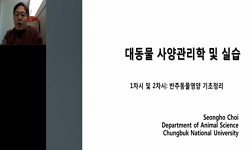Interaction between carcass quality grade and end-point cooking temperature on eating quality of Hanwoo m. longissimus was investigated. Ten (10) of steers were sampled from a commercial population; carcasses with QG 1++ (n=5) and QG 1 (n=5) were chos...
http://chineseinput.net/에서 pinyin(병음)방식으로 중국어를 변환할 수 있습니다.
변환된 중국어를 복사하여 사용하시면 됩니다.
- 中文 을 입력하시려면 zhongwen을 입력하시고 space를누르시면됩니다.
- 北京 을 입력하시려면 beijing을 입력하시고 space를 누르시면 됩니다.



Eating Quality Traits of Hanwoo longissimus dorsi Muscle as a Function of End-Point Cooking Temperature
한글로보기https://www.riss.kr/link?id=A105445338
- 저자
- 발행기관
- 학술지명
- 권호사항
-
발행연도
2016
-
작성언어
-
- 주제어
-
KDC
527
-
등재정보
SCIE,SCOPUS,KCI등재
-
자료형태
학술저널
- 발행기관 URL
-
수록면
291-299(9쪽)
- 제공처
-
0
상세조회 -
0
다운로드
부가정보
다국어 초록 (Multilingual Abstract)
Interaction between carcass quality grade and end-point cooking temperature on eating quality of Hanwoo m. longissimus was investigated. Ten (10) of steers were sampled from a commercial population; carcasses with QG 1++ (n=5) and QG 1 (n=5) were chosen. Samples were cooked by electric oven at 60 or 82°C and compared with uncooked control samples. The pH was not affected by cooking temperature but decreased the redness after cooking and steaks cooked at 60°C were more reddish than steaks cooked at 82°C in both QG groups. Higher cooking temperature greatly (p<0.05) increased the cooking loss, but there was no significant interaction between cooking temperature and QG on the cooking loss. Moisture is negatively correlated with temperature in both QG while the proportionate relationship between crude fat and end-point temperature found in QG 1++. WBSF values were significantly (p<0.05) high for QG 1, while that was significantly (p<0.05) increased when the temperature continues to increase. The increasing quality grade of beef resulted in significant higher (p<0.01) level of TBARS and cooking temperature increased TBARS content. Fatty acid composition was not altered by cooking at both temperatures and also the amount of fat intake was not changed. The current study indicates that eating quality of beef m. longissimus was greatly influenced by end-point temperature being interacted with QG. However, the amount and composition of fat were stable regardless of end-point temperatures. These results will provide a consumer reference to determine cooking conditions and intramuscular fat content.
동일학술지(권/호) 다른 논문
-
- Korean Society for Food Science of Animal Resources
- Yu, Hyung-Seok
- 2016
- SCIE,SCOPUS,KCI등재
-
- Korean Society for Food Science of Animal Resources
- Jung, Jieun
- 2016
- SCIE,SCOPUS,KCI등재
-
- Korean Society for Food Science of Animal Resources
- Muhlisin, Muhlisin
- 2016
- SCIE,SCOPUS,KCI등재
-
Effects of Whey Powder Supplementation on Dry-Aged Meat Quality
- Korean Society for Food Science of Animal Resources
- Kim, Ji-Han
- 2016
- SCIE,SCOPUS,KCI등재




 스콜라
스콜라


